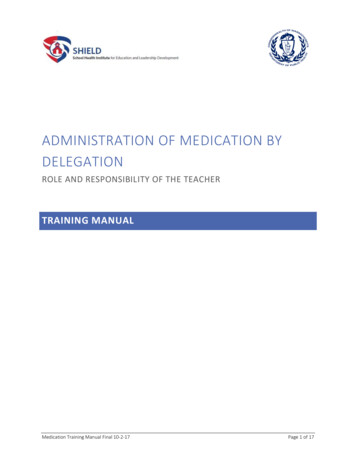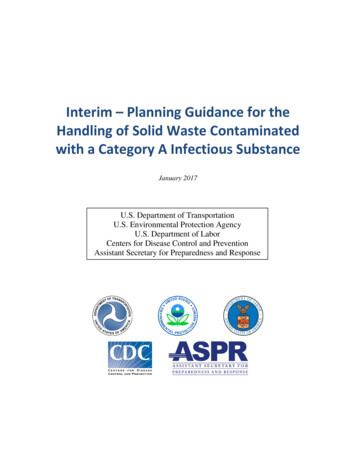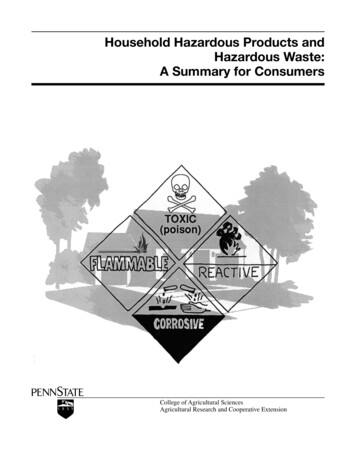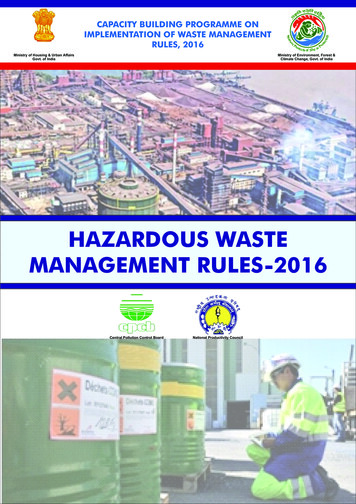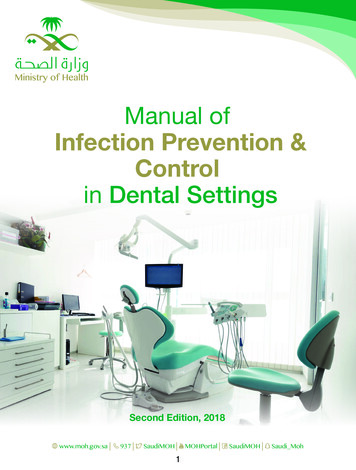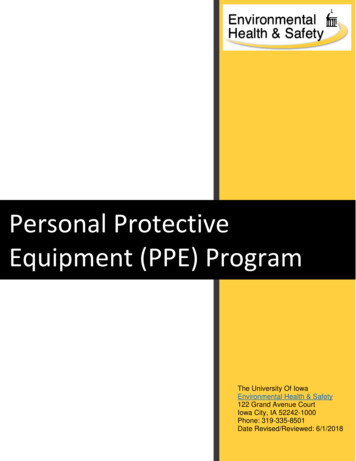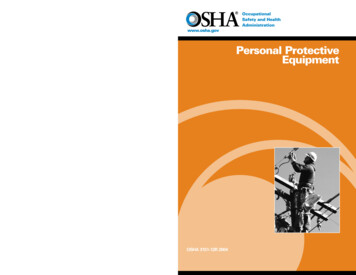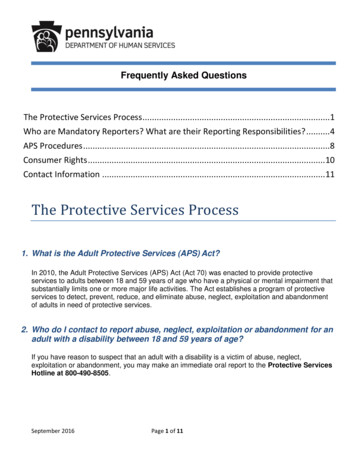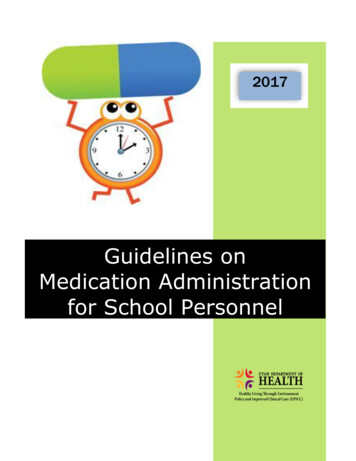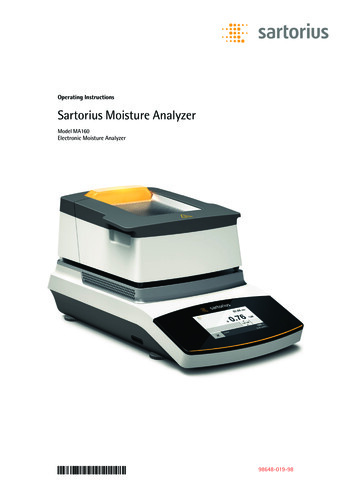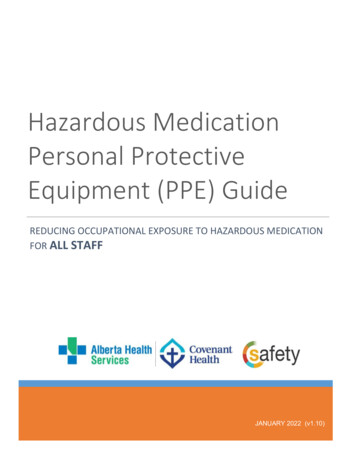
Transcription
Hazardous MedicationPersonal ProtectiveEquipment (PPE) GuideREDUCING OCCUPATIONAL EXPOSURE TO HAZARDOUS MEDICATIONFOR ALL STAFFJANUARY 2022 (v1.10)
2018, 2020, 2021, 2022 Alberta Health Services (Pharmacy Services, Health Professions Strategy andPractice and Workplace Health and Safety) and Covenant Health (Pharmacy Services)This work is licensed under the Creative Commons Attribution-NonCommercial-ShareAlike 4.0International License. To view a copy of this license, visit http://creativecommons.org/licenses/by-ncsa/4.0/. The license does not apply to AHS or Covenant Health logos and trademarks or third partyworks licensed by AHS or Covenant Health.DisclaimerThis material is intended for general information only and is provided on an “asis,” “where is” basis. Although reasonable efforts were made to confirm theaccuracy of the information, neither Alberta Health Services nor Covenant Healthmake any representation or warranty, express, implied or statutory, as to theaccuracy, reliability, completeness, applicability or fitness for a particularpurpose of such information. This material is not a substitute for the advice ofa qualified health professional. Each of Alberta Health Services and CovenantHealth expressly disclaims all liability for the use of these materials, and forany claims, actions, demands or suits arising from such use.iJANUARY 2022 (v1.10)
PreambleThe Alberta Health Services (AHS) / Covenant Health (COV) Hazardous Medication PersonalProtective Equipment (PPE) Guide – Reducing Occupational Exposure Risks to HazardousMedication for Staff has been developed to provide guidance for safe handling of hazardousmedication in AHS and Covenant Health and to reduce occupational exposure of staff.This document is intended to provide guidance to all AHS and COV Health employees,members of the medical and midwifery staffs, students, volunteers, and other persons acting onbehalf of AHS or COV Health (including contracted service providers as necessary) regardingthe PPE required to handle hazardous medications safely.This document does not provide guidance on the scope of practice required for administration ofhazardous medications.The AHS / COV Health Hazardous Medication PPE Guide in conjunction with the HazardousMedication List provide general guidance for some of the possible scenarios that staff mayencounter in AHS / COV Health, but may not cover all possible situations.The Provincial Hazardous Medication Committee (PHMC) has separated the HazardousMedication Personal Protective Equipment (PPE) Guide and AHS Hazardous MedicationList to allow updates to the list in a timely mannerWhen in doubt, protect yourself from occupational exposure to hazardousmedication.1JANUARY 2022 (v1.10)
Table of ContentsPreamble . 1Hazardous Medication and Occupational Exposure . 6What is a Hazardous Medication? . 6What is Occupational Exposure? . 6Reducing Occupational Exposure in the Workplace . 6Spill Management . 7Hierarchy of Hazard Control . 7Hazard vs. Risk – What’s the Difference? . 8Who Does This Apply To? . 9Classification of Hazardous Medication . 10KNOWN Hazard Medication . 11POTENTIAL Hazard Medication . 11REPRODUCTIVE Hazard Medication . 11Non-sterile Compounds and Hazardous Medications in AHS / COV Health Pharmacies (applicable topharmacy only) . 12Labelling of Hazardous Medication . 13Personal Protective Equipment (PPE) Equipment that protects staff from exposure to hazardousmedication. . 14Disposal of Used PPE and Hazardous Medication Waste . 15Hazardous Medications Handling Risk Assessment (HMHRA). 16Chapter 1 KNOWN Hazard Medication .18Pharmacy Services Staff .19Receiving, Unpacking and Stocking of KNOWN Hazard Medication in Pharmacy. 20Delivery of KNOWN Hazard Medication within AHS / COV Facilities from Pharmacy . 20Handling, Packaging and Preparation of Non-Sterile Preparations: KNOWN Hazard Medication . 21Preparation of Compounded Sterile Preparations (CSPs): KNOWN Hazard Medication . 22Spill Management of KNOWN Hazard Medication in Pharmacy . 23Cleaning of Areas Involving KNOWN Hazard Medication in Pharmacy . 24Handling KNOWN Hazard Medication Waste Containers. 24Frontline Clinical Staff .25Receiving, Storing and Delivery of KNOWN Hazard Medication in Patient Care Areas. 26Spill Management of KNOWN Hazard Medication . 262JANUARY 2022 (v1.10)
Preparation and Administration of KNOWN Hazard Medication in Patient Care Areas . 27Handling Human Waste . 28Handling Patient Specimens . 28Handling KNOWN Hazard Medication Waste Containers. 28Handling Human Waste . 29Handling Patient Specimens . 29Handling Medication Waste Containers . 29Frontline Non-Clinical Staff.30Receiving, Storage and Delivery of KNOWN Hazard Medication . 31Spill Management of KNOWN Hazard Medication . 31Handling Human Waste . 31Handling KNOWN Hazard Medication Waste Containers. 31Nutrition & Food Services and Linen & Environmental Services Staff .32Spill Management of KNOWN Hazard Medication . 33Cleaning of Areas Involved in KNOWN Hazard Medication . 33Handling Soiled Linen within Linen Processing Area . 33Handling KNOWN Hazard Medication Waste Containers. 33Cleaning of Patient Care Areas and / or Handling Human Waste DURING the Precautionary PeriodWhen Signage is Posted . 34Handling Soiled Linen in Patient Care Areas DURING the Precautionary Period When Signage is Posted. 34Cleaning of Patient Care Areas and / or Handling Human Waste AFTER the Precautionary Period WhenSignage is No Longer Posted . 35Handling Soiled Linen in Patient Care Areas AFTER the Precautionary Period When Signage is NoLonger Posted . 35Chapter 2 POTENTIAL & REPRODUCTIVE Hazard Medication.36Pharmacy Services Staff .37Receiving, Unpacking and Stocking of POTENTIAL & REPRODUCTIVE Hazard Medication in Pharmacy38Delivery of POTENTIAL & REPRODUCTIVE Hazard Medication within AHS / COV Facilities fromPharmacy . 38Handling and Packaging of Non-Sterile Preparations: POTENTIAL & REPRODUCTIVE Hazard Medication. 39Cleaning of Areas Involving POTENTIAL & REPRODUCTIVE Hazard Medication in Pharmacy. 393JANUARY 2022 (v1.10)
Compounding of Non-Sterile Preparations (Levels B, B )*: POTENTIAL & REPRODUCTIVE HazardMedications . 40Preparation of Compounded Sterile Preparations (CSPs): POTENTIAL & REPRODUCTIVE HazardMedication . 41Spill Management of POTENTIAL & REPRODUCTIVE Hazard Medication in Pharmacy . 42Cleaning of Areas Involving POTENTIAL & REPRODUCTIVE Hazard Medication in Pharmacy. 43Handling POTENTIAL & REPRODUCTIVE Hazard Medication Waste Containers . 43Frontline Clinical Staff .44Receiving, Storage and Delivery of POTENTIAL & REPRODUCTIVE Hazard Medication in Patient CareAreas . 45Spill Management of POTENTIAL & REPRODUCTIVE Hazard Medication in Patient Care Areas . 45Preparation and Administration of POTENTIAL & REPRODUCTIVE Hazard Medication in Patient CareAreas . 46Handling Human Waste . 47POTENTIAL and REPRODUCTIVE RISK hazardous medications on the AHS Hazardous Medication List donot require a precautionary period. . 47Handling Patient Specimens . 47Handling POTENTIAL & REPRODUCTIVE Hazard Medication Waste Containers . 47Frontline Non-Clinical Staff.48Receiving, Storage and Delivery of POTENTIAL & REPRODUCTIVE Hazard Medication . 49Spill Management of POTENTIAL & REPRODUCTIVE Hazard Medication. 49Handling Human Waste . 49Handling POTENTIAL & REPRODUCTIVE Hazard Medication Waste Containers . 49Nutrition & Food Services Staff and Linen & Environmental Services Staff .50POTENTIAL and REPRODUCTIVE RISK hazard medications on the AHS Hazardous Medication List donot require a precautionary period. . 51Spill Management of POTENTIAL & REPRODUCTIVE Hazard Medication. 51Cleaning of Areas Involved in POTENTIAL & REPRODUCTIVE Hazard Medication . 51Handling Soiled Linen. 51Cleaning of Patient Care Areas and Handling Human Waste . 51Handling POTENTIAL & REPRODUCTIVE Hazard Medication Waste Containers . 51Acronyms and Definitions .52Appendix A: Special Handling Considerations for Specified Hazardous Medication .55 BCG vaccine (bacillus calmette Guerin) . 554JANUARY 2022 (v1.10)
Monoclonal Antibodies (mAbs) . 55 Pentamidine . 55Appendix C: Hierarchy of Control .56Appendix D: Reproductive Population Subset .57Resources and References .585JANUARY 2022 (v1.10)
Hazardous Medication and OccupationalExposureWhat is a Hazardous Medication?Hazardous medication are those medications that, although therapeutic to the patient, areknown to or suspected to pose a health risk to health care workers exposed to them in theworkplace due to the medication’s inherent toxicity. According to the National Institute forOccupational Safety and Health (NIOSH) they exhibit one or more of the followingcharacteristics in humans or animals: Carcinogenicity – capable of causing or promoting the development of cancer or a lesionwhich could be the starting point of a cancer Teratogenicity or other developmental toxicity – capable of causing congenitalmalformations due to an action on the embryo Genotoxicity – capable of damaging genetic material (DNA) to cause mutations Reproductive toxicity – capable of affecting fertility (i.e. miscarriages, late fetal death,infertility) Organ toxicity at low doses – capable of causing serious organ or other toxic effects at alow dose (i.e. liver damage, local necrosis of exposed tissue) Structure and toxicity profiles of medication that mimic existing medication determinedhazardous by the above criteriaSee Appendix A: Special Handling Considerations for Specified Hazardous MedicationWhat is Occupational Exposure?Occupational exposure occurs during the performance of job duties and may place staff at riskof adverse health effects. Occupational exposure to hazardous medication may occur throughinhalation, skin contact, ingestion or injection and may be associated with either frequentexposure to low levels of hazardous medication, or a single exposure to a larger amount.Exposure to hazardous medication may occur at all points of the medication circuit includingreceiving, preparing and administering the medication, handling contaminated supplies andmaterials, disposing of hazardous medication and associated hazardous waste and handlingcontaminated materials such as patient waste.Reducing Occupational Exposure in the WorkplaceThe following key concepts help reduce occupational exposure to hazardous medication:6JANUARY 2022 (v1.10)
Use of engineering controls (e.g., biological safety cabinet (BSC), closed-system transferdevices (CSTD)) Wearing of Personal Protective Equipment (PPE) Safe work practices (e.g., following spill procedures, standard cleaning practices) Determination of the risk of inhalation, or risk of spill or splashStaff can mitigate possible exposure to hazardous medication by using one or more of thefollowing minimum precaution recommendations when handling medication: Wearing appropriate PPE indicated in this guide Practicing “touchless technique” Practicing good hand hygieneSpill ManagementSpill kits must be available in locations where hazardous medication are handled. All contentsshould be verified regularly, including checking of expiration dates.Hierarchy of Hazard ControlThe Hierarchy of Hazard Control offers a complete framework used by companies to minimizeor eliminate exposure to hazards. Elimination and substitution of the hazard are the mosteffective options; however, this is not always possible when referring to hazardous medication.Engineering controls, administrative controls and PPE are all important aspects of handling ofhazardous medication; however, this document will only address the use of appropriate PPE.See Appendix B: Hierarchy of Hazard Controls7JANUARY 2022 (v1.10)
Hazard vs. Risk – What’s the Difference?Often the two words are used interchangeably, however, in terms of risk assessment they havevery distinct meanings.A risk is the chance,high or low, that anyhazard will actuallycause someoneharmA hazard is somethingthat can cause harmHazard x Exposure RiskA hazard poses no risk if there is not an exposure to that hazard.Factors that influence the degree of risk include: How often and for how long a person is exposed to a hazardous object or condition. How the person is exposed (e.g., breathing in vapors, skin contact). How severe the effects are under the conditions of exposure.8JANUARY 2022 (v1.10)
Who Does This Apply To?This document has been prepared to provide guidance to the following staffing groups:PharmacyServicesFrontline ClinicalFrontlineNon-ClinicalNutrition & FoodServices andLinen &EnvironmentalServices Pharmacists Pharmacy Assistants Pharmacy Technicians Pharmacy Students Allied Health Professionals Diagnostic Imaging (DI) Staff Healthcare Aides Laboratory Technologists and Assistants Nursing Practitioners Nurse Staff Paramedics Physicians and Medical Residents Respiratory Therapists Students Contracting Procurement and Supply Management (CPSM) Porters Service Staff (e.g. Corrections) Unit Clerks Environmental Services Staff Linen Services Nutrition & Food Services Staff9JANUARY 2022 (v1.10)
Classification of Hazardous MedicationNIOSH List of Hazardous Drugs in Healthcare Settings, 2020(currently in draft)Table 1: Table 1 now includes drugs that meet the NIOSH definition of a hazardous drug andcontain MSHI in the package insert; and/or are classified by the NTP as “known to be ahuman carcinogen,” or classified by IARC as “carcinogenic” or “probably carcinogenic.”In the 2016 List this table identified antineoplastic drugs, however, in this update not allof the drugs on Table 1 are antineoplastic drugs.Table 2: Table 2 contains drugs that meet one or more of the NIOSH definition of a hazardousdrug but are not drugs which have MSHI or are classified by the NTP as “known to be ahuman carcinogen,” or classified by the IARC as “carcinogenic” or “probablycarcinogenic,” some of which also have adverse reproductive effects for populations atrisk. This table now also includes drugs that only meet the NIOSH criteria as adevelopmental (including teratogenicity) and/or reproductive hazard. In the 2016 updateof the List this table did not include drugs that only posed a developmental and/orreproductive hazard.In the 2016 List, Table 3 provided a list of drugs that met the NIOSH criteria of a reproductivehazard (damaging to a male or female person’s ability to conceive or carry to term an offspring) ordevelopmental hazard (able to cause disruption in the development of unborn children includingteratogenic outcomes). In this 2020 List, those drugs that only meet NIOSH’s criteria as adevelopmental and/or reproductive hazard are identified in the supplemental information columnwith a blue notification; a separate Table is no longer provided.Alberta Health Services will continue to classify hazardous medications as KNOWN, POTENTIALor REPRODUCTIVE10JANUARY 2022 (v1.10)
Alberta Health Services / Covenant HealthHazardous Medication ClassificationKNOWN HazardMedicationThese medications are mainly antineoplastic medications as perNational Institute for Occupational Safety and Health (NIOSH) Table 1,predominantly used in the treatment of cancer (chemotherapy) and insome cases, used for the treatment of other conditions (e.g., psoriasis,rheumatoid arthritis). KNOWN hazard medications are carcinogenic,cytotoxic and/or have manufacturer special handling information (MSHI)to protect workers handling the medications. Not all KNOWN hazardmedications are cytotoxic or anti-neoplastic.These medications present a serious risk to the health or welfare ofhealthcare staff during occupational exposurePOTENTIAL HazardMedicationThese medications meet one or more of NIOSH’s criteria for ahazardous medication but are not drugs that are known to becarcinogenic or probably carcinogenic.These are mainly non-antineoplastic medications that only meet theNIOSH criteria as a developmental and/or reproductive hazard. Theyare not drugs that are known or probable carcinogenic agents.REPRODUCTIVEHazard MedicationThese medications may present an occupational exposure risk only forcertain individuals; staff of childbearing years regardless of gender with apotential to conceive or fertilize, women who are pregnant, or womenwho are breast feeding.Should staff members have specific questions, they should discuss withtheir supervisors in consultation with their personal physicians andWorkplace Health and Safety (WHS) to assess the risk of occupationalexposure to these medication and the option of temporarily refrainingfrom handling hazardous medications.Certain Reproductive Hazard Medications may only be applicable to asubset of the Reproductive population; see key points below11JANUARY 2022 (v1.10)
Non-sterile Compounds and Hazardous Medications in AHS / COV HealthPharmacies (applicable to pharmacy only)Alberta College of Pharmacy (ACP) has mandated that all non-sterile compounds receive an assessmentof the health and safety risk to staff. Each recipe has been evaluated and assigned a rating level basedon health risk. The required PPE varies based on rating level. As many of the compounds are alsohazardous, the recommendations have been incorporated into this edRationaleSafety DescriptionSpecific PPERequired in AHSADesignated areawithin thepharmacySimple or moderate prepsthat pose little or no risk topersonnelStandard precautions aresufficient to prepare thecompound safelyOne pair of gloves,protective gown, haircover, surgical face maskBA dedicated roomseparate from therest of thepharmacyAdditional PPE is required toprepare the compoundsafelyB Room must beclosed andventilated ORmust contain aventilatedcontainmentdevice.A room undernegative pressureand a ventilatedcontainmentdeviceComplex preps or those thatpose more risk than level A(e.g. potential hazard meds)but do not pose ventilationrisksThe same as level B above butalso pose ventilation risks(e.g. powders, allergens,hormones)One pair of gloves,protective gown, haircover, surgical facemask, plus goggles/faceshield (liquids)Option 1: All of theabove in B, plus N95respiratorOption 2: Standard PPEin A plus a ventilatedcontainment deviceKnown hazard meds (NIOSHgroup 1)Additional PPE andventilation equipment isrequired to prepare thecompound safely.Segregation is needed toprevent cross-contaminationCAdditional PPE is requiredincluding ventilationequipment2 pairs of chemotherapyrated gloves, chemorated gown, hair cover, 2pairs of shoe covers,surgical mask andventilated containmentdevice*Note: Where preparation occurs in a cleanroom used for hazardous sterile preparations, PPE defaultsto the higher standard. E.g. Gloves must be sterile.12JANUARY 2022 (v1.10)
Labelling of Hazardous MedicationLabelling of hazardous medication is important to provide a visual cue to staff that themedication is hazardous and presents an occupational exposure risk.Note: many of these are AHS custom labels. Hazardous medications procured throughcommunity pharmacies may not have the same labels.LabelApplicationThis label will be applied to those hazardousmedications that are a KNOWN hazard.This label will be applied to those hazardousmedications that are a POTENTIAL hazard.This label will be applied to those hazardousmedications that are a REPRODUCTIVE HAZARD.HAZ.Med.For Labelling of Patient Specimens, refer to KNOWNHazardous Medication Specimen labelNOTE: Medication packaged in pharmacy packaging machines may come with a“HAZARDOUS” warning on the outer package in black ink, rather than one of the abovecoloured auxiliary labels.13JANUARY 2022 (v1.10)
Personal Protective Equipment (PPE) Equipment that protects staff fromexposure to hazardous medication.PPEICONDescriptionChemo Rated Gloves: Are high quality, powder free gloves made of either latex, nitrile,Glovespolyurethane, neoprene, polychloroprene that meet the American Society for Testing andMaterials (ASTM) standard (ASTM D6978 – 05) for chemotherapy permeability (includes sterileand non-sterile gloves). In AHS, the non-sterile powder free nitrile gloves are ASTM rated forchemo permeability.Chemo Rated Gowns: Are disposable moisture resistant (DMR) gowns made of strong,Gownsbreathable, non-linting polyethylene material or with vinyl coatings, long sleeves with tight-fittingcuffs, full back with waist tie closure, solid front, and tie or Velcro neck. These gowns havebeen tested by the manufacturers against the top chemotherapy drugs. Based on NIOSH andother evidence, chemo rated gowns are used for KNOWN hazard medication.Protective Gowns: Are blue (yellow in Covenant Health) disposable moisture resistant gownsmade of strong, breathable polypropylene material long sleeves with soft knit cuffs, a full back, afull back with waist tie closure, and tie neck. These gowns do not provide the level of protectionto be used for KNOWN hazard medications. Protective gowns are used for POTENITAL andREPRODUCTIVE hazard medications.N95 Respirator: a filtering face piece respirator that filters out airborne non-oil basedparticulates* and is certified to be at least 95% efficient when correctly selected and used.Wearers must be fit tested to ensure a tight seal is achieved against the face directing inhaled airthrough the filter material.RespiratoryProtectionChemical Cartridge Respirator: (Pharmacy Use Only) A face mask respirator that, when wornproperly, filters gases and vapors from the air. They must be fit tested to ensure a tight seal andworn properly to ensure thathazardous vapors are not inhaled. Available as a half face piecerespirator to be worn with goggles and face shield for staff with eyeglasses.Surgical Mask: A loose-fitting single-use filtration device worn over the nose and mouth of staffto prevent their contaminants being released into the immediate environment and to protect thewearer from spray or splash.Eye andFaceProtectionHead Coverand FacialHair CoverShoeCoversGoggles: Must be face sealing without side vents or with indirect venting onlyFace Shield: Must be long enough to cover the nose and mouth.Hair Covers / Bouffant / Hijab Cover: Must cover all exposed hair and/or hijab completely.Facial Hair Cover: Must cover all facial hair completely, if applicable.Shoe Cover: Disposable, single use.*particulates could be dusts, fumes, and mists from airborne transmission communicable diseases; wearing an N95offers no protection from gases and vapors.NOTE: if a patient is
1 JANUARY 2022 (v1.10) Preamble . The Alberta Health Services (AHS) / Covenant Health (COV) Hazardous MedicationPersonal Protective Equipment (PPE) Guide - Reducing Occupational Exposure Risks to Hazardous Medication for Staff has been developed to provide guidance for safe handling of hazardous medication in AHS and Covenant Health and to reduce occupational exposure of staff.

